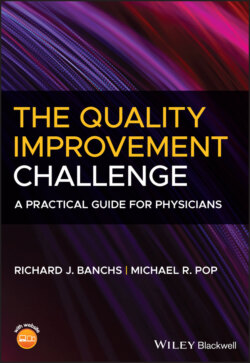Читать книгу The Quality Improvement Challenge - Richard J. Banchs - Страница 40
HOW TO ESTABLISH YOUR PROJECT’S TIMELINES
ОглавлениеAdministrators, sponsors, and clinical leaders may require an estimated project duration to monitor the project and ascertain when they can expect project deliverables. Other project stakeholders and frontline employees may need to know the estimated project timeline to evaluate the feasibility of their participation in the project. All face multiple competing priorities every day. They may hesitate to become involved in your project if they fear the project is going to interfere with their other responsibilities. You should develop a project schedule based on realistic estimates of activity duration prior to engaging team members. The two most common scheduling practices are schedule set and PERT:
Schedule set. The QI team may receive the expected timeline for implementation of process improvements by senior leadership or the primary sponsor. Based on the expected date of project completion, you may have to work backward to determine the amount of time you can allocate for each activity to develop the project schedule. Schedule activity estimates can be a one‐point, best‐guess estimate based on your quality improvement experience in conducting similar process improvement projects, or historical information from the organization’s subject‐matter experts. These estimates can provide a general guide to a projected project timeline, initially with progressive specificity as the project activities unfold.
Program Evaluation and Review Technique (PERT). Another way to develop a schedule is to use the Program Evaluation and Review Technique, which relies on historical information or expert opinions to approximate optimistic, pessimistic, and most likely estimates of the duration of each activity, which are then combined to yield the project schedule. The formula for determining the activity duration using PERT is: (O + P + 4ML) / 6, where O is the optimistic estimate, P is the pessimistic estimate, and ML is the most likely estimate.
Regardless of the method of estimating that is used, the schedule will need to be updated when new information becomes available. You may need to align your project activities with the schedule, as the project team members, leaders, local sponsors, and frontline stakeholders usually have multiple conflicting priorities with restricted availability for project work. When the schedule gets off track, two schedule‐compression techniques may be employed in an attempt to restore the timeline:
Parallel processing involves performing two activities that are usually completed in a sequential manner in a parallel manner instead. This technique increases the risk of rework due to the change in the process.
Crashing involves using additional human resources to complete the activity faster. This technique impacts the cost of the project according to the type and number of resources used. It may also be performed to conduct a pilot to evaluate the effectiveness of the new process and justify additional resources.
By developing a tentative project schedule and updating it as new information becomes available, you will be able to estimate and manage project resources more efficiently and effectively.
